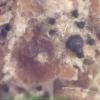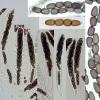
24-12-2025 17:08
Hulda Caroline HolteHello, I have found this propoloid ascomycete on

21-12-2025 09:32
Hello.A tiny ascomycete found embedded in wood in

21-12-2025 21:32
Pol DebaenstHello, Garden, Burgweg 19, Veurne, BelgiumOn 10/1

22-12-2025 23:38
Patrice TANCHAUDBonsoir, récolte sur un mur en pierre, apothéci

22-12-2025 00:47
Patrice TANCHAUDBonsoir, récolte à proximité du milieu dunaire
The spores are (26.7) 27.8 - 34.9 (36.9) × (4.8) 5.0 - 6.3 (6.8) µm, soon breaking up into four part spores. The asci are (108.7) 120.4 - 151.5 (184.7) × (10.1) 11.6 - 14.2 (14.6) µm. Other details in the photos.
Ideas, anybody?
------
Update: I was wrong about the substrate - it is black grouse (Tetrao/Lyrurus tetrix).
Why not minima?

Look towards S.minimoides, the germinal clefts correspond better. The spores and measurements of these two species are quite variable.
Michel.
The pseudothecia are about double size when compared to descriptions of minimoides. I measured the the part of the ascus base to the lowest spore and got these results (11.5) 13.8 - 58 (101.9) µm, Me = 33.9 µm while Ahmed & Cain say 4-6 µm. The spore width is a better match with minima than with minimoides.
I also compared to these and other photos:
https://www.pilzforum.eu/board/thread/46967-sporormiellas-aus-namibia/
Minimoides is said to be a thermophilic species. This specimen was collected on grey dunes on a south facing slope exposed to sun all day, so the thermophily criterion is fulfilled. The species is on the Finnish checklist but I know no details about that.
I feel that the differences are too big for this to be minimoides. But then my experience of this genus is limited

Pilzforum.eu is my favourite site what comes to coprophilous species. Unfortunately I don't write German even though I can read it. Thank you, Norbert!

Taking all the information and the latest details, I wonder if S.leporina would not be more suitable for the length of the spores as well as their shape.
Michel.



I did not observe that that there are spores of two different sizes.
In Helotiales there is a length difference between living and dead spores of 6-18 percent. Or ascus width 17-26 percent reduction. I suppose the situation could be the same also for perithecial/psedothecial fungi. Perhaps when measuring living material reduce by x percent before compairing to Ahmed & Cain?
Stefan

